英语专四语法总结—非谓语动词的其他考点
- 格式:doc
- 大小:27.50 KB
- 文档页数:2
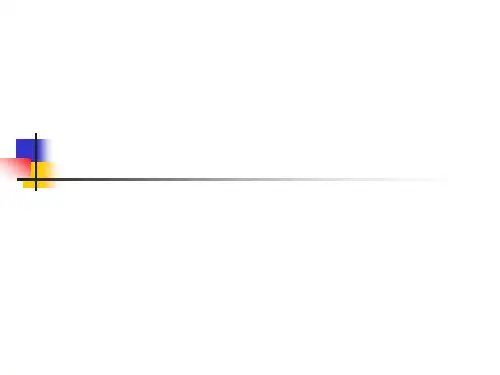
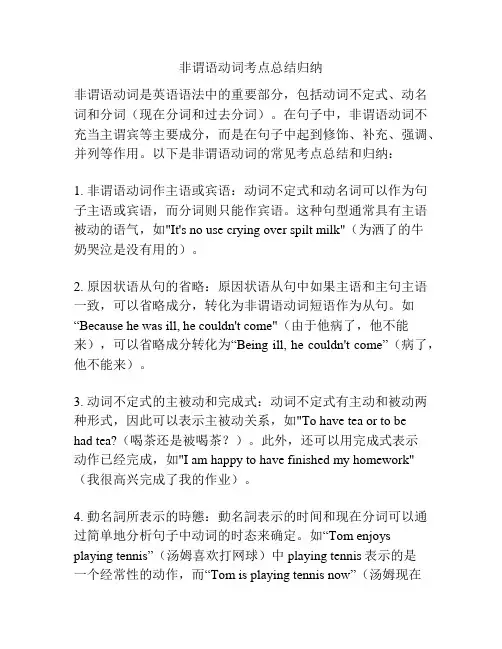
非谓语动词考点总结归纳非谓语动词是英语语法中的重要部分,包括动词不定式、动名词和分词(现在分词和过去分词)。
在句子中,非谓语动词不充当主谓宾等主要成分,而是在句子中起到修饰、补充、强调、并列等作用。
以下是非谓语动词的常见考点总结和归纳:1. 非谓语动词作主语或宾语:动词不定式和动名词可以作为句子主语或宾语,而分词则只能作宾语。
这种句型通常具有主语被动的语气,如"It's no use crying over spilt milk"(为洒了的牛奶哭泣是没有用的)。
2. 原因状语从句的省略:原因状语从句中如果主语和主句主语一致,可以省略成分,转化为非谓语动词短语作为从句。
如“Because he was ill, he couldn't come"(由于他病了,他不能来),可以省略成分转化为“Being ill, he couldn't come”(病了,他不能来)。
3. 动词不定式的主被动和完成式:动词不定式有主动和被动两种形式,因此可以表示主被动关系,如"To have tea or to behad tea?(喝茶还是被喝茶?)。
此外,还可以用完成式表示动作已经完成,如"I am happy to have finished my homework"(我很高兴完成了我的作业)。
4. 動名詞所表示的時態:動名詞表示的时间和现在分词可以通过简单地分析句子中动词的时态来确定。
如“Tom enjoys playing tennis”(汤姆喜欢打网球)中playing tennis表示的是一个经常性的动作,而“Tom is playing tennis now”(汤姆现在正在打网球)中playing tennis则表示现在正在进行的动作。
5. 分词作定语:现在分词和过去分词经常用作定语修饰名词,如shining stars(闪闪发亮的星星)、a book written by Hemmingway(海明威写的一本书)。

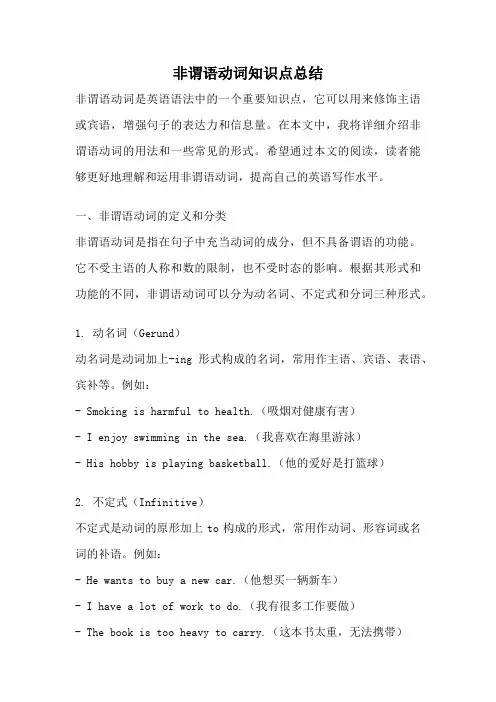
非谓语动词知识点总结非谓语动词是英语语法中的一个重要知识点,它可以用来修饰主语或宾语,增强句子的表达力和信息量。
在本文中,我将详细介绍非谓语动词的用法和一些常见的形式。
希望通过本文的阅读,读者能够更好地理解和运用非谓语动词,提高自己的英语写作水平。
一、非谓语动词的定义和分类非谓语动词是指在句子中充当动词的成分,但不具备谓语的功能。
它不受主语的人称和数的限制,也不受时态的影响。
根据其形式和功能的不同,非谓语动词可以分为动名词、不定式和分词三种形式。
1. 动名词(Gerund)动名词是动词加上-ing形式构成的名词,常用作主语、宾语、表语、宾补等。
例如:- Smoking is harmful to health.(吸烟对健康有害)- I enjoy swimming in the sea.(我喜欢在海里游泳)- His hobby is playing basketball.(他的爱好是打篮球)2. 不定式(Infinitive)不定式是动词的原形加上to构成的形式,常用作动词、形容词或名词的补语。
例如:- He wants to buy a new car.(他想买一辆新车)- I have a lot of work to do.(我有很多工作要做)- The book is too heavy to carry.(这本书太重,无法携带)3. 分词(Participle)分词是动词的-ing形式(现在分词)或-ed、-en等形式(过去分词)构成的形容词,常用作定语、状语或补语。
例如:- The running water is very clear.(流动的水非常清澈)- The broken vase has been repaired.(打破的花瓶已经修好了)- We were surprised by the exciting news.(令人兴奋的消息让我们感到惊讶)二、非谓语动词的用法非谓语动词在句子中具有独立的语法功能,可以用来修饰名词、代词、动词、形容词和副词等,以及构成复合句的各种从句。

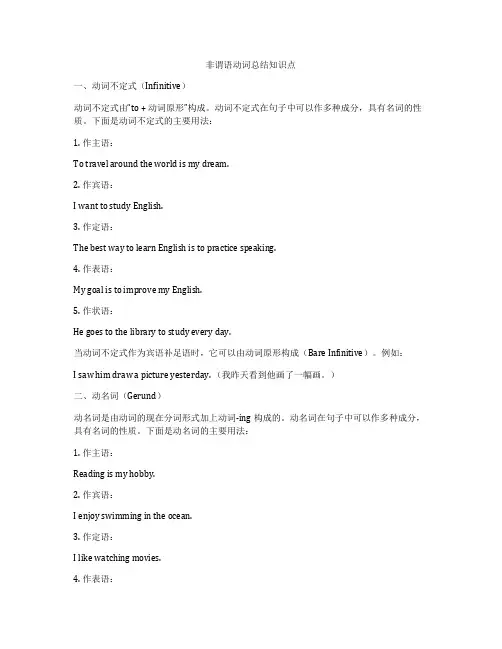
非谓语动词总结知识点一、动词不定式(Infinitive)动词不定式由“to + 动词原形”构成。
动词不定式在句子中可以作多种成分,具有名词的性质。
下面是动词不定式的主要用法:1. 作主语:To travel around the world is my dream.2. 作宾语:I want to study English.3. 作定语:The best way to learn English is to practice speaking.4. 作表语:My goal is to improve my English.5. 作状语:He goes to the library to study every day.当动词不定式作为宾语补足语时,它可以由动词原形构成(Bare Infinitive)。
例如:I saw him draw a picture yesterday. (我昨天看到他画了一幅画。
)二、动名词(Gerund)动名词是由动词的现在分词形式加上动词-ing构成的。
动名词在句子中可以作多种成分,具有名词的性质。
下面是动名词的主要用法:1. 作主语:Reading is my hobby.2. 作宾语:I enjoy swimming in the ocean.3. 作定语:I like watching movies.4. 作表语:His favorite activity is playing basketball.5. 作状语:He left without saying goodbye.动名词与不定式的区别在于,动名词具有名词的性质,而动词不定式具有动词的性质。
例如:I like swimming. (我喜欢游泳。
)I like to swim. (我喜欢游泳。
)动名词与动词不定式作宾语时,有时可以根据动词选择使用不定式还是动名词。
例如:I stopped smoking. (我戒烟了。
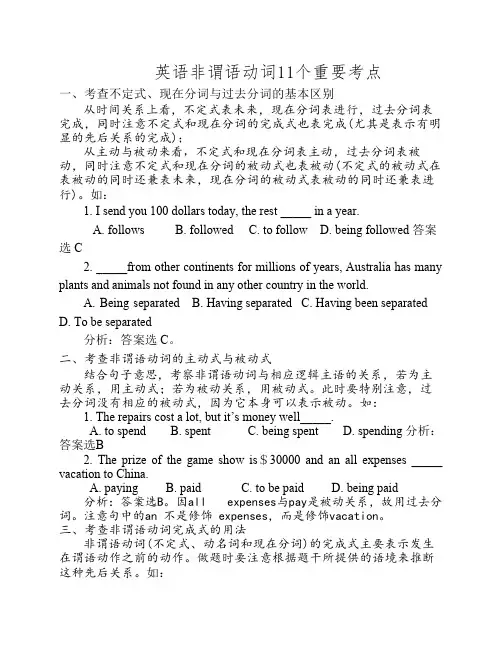
英语非谓语动词11个重要考点一、考查不定式、现在分词与过去分词的基本区别从时间关系上看,不定式表未来,现在分词表进行,过去分词表完成,同时注意不定式和现在分词的完成式也表完成(尤其是表示有明显的先后关系的完成);从主动与被动来看,不定式和现在分词表主动,过去分词表被动,同时注意不定式和现在分词的被动式也表被动(不定式的被动式在表被动的同时还兼表未来,现在分词的被动式表被动的同时还兼表进行)。
如:1. I send you 100 dollars today, the rest _____ in a year.A. followsB. followedC. to followD. being followed 答案选 C2. _____from other continents for millions of years, Australia has many plants and animals not found in any other country in the world.A. Being separatedB. Having separatedC. Having been separatedD. To be separated分析:答案选 C。
二、考查非谓语动词的主动式与被动式结合句子意思,考察非谓语动词与相应逻辑主语的关系,若为主动关系,用主动式;若为被动关系,用被动式。
此时要特别注意,过去分词没有相应的被动式,因为它本身可以表示被动。
如:1. The repairs cost a lot, but it’s money well_____.A. to spendB. spentC. being spentD. spending 分析:答案选B2. The prize of the game show is$30000 and an all expenses _____ vacation to China.A. payingB. paidC. to be paidD. being paid分析:答案选B。
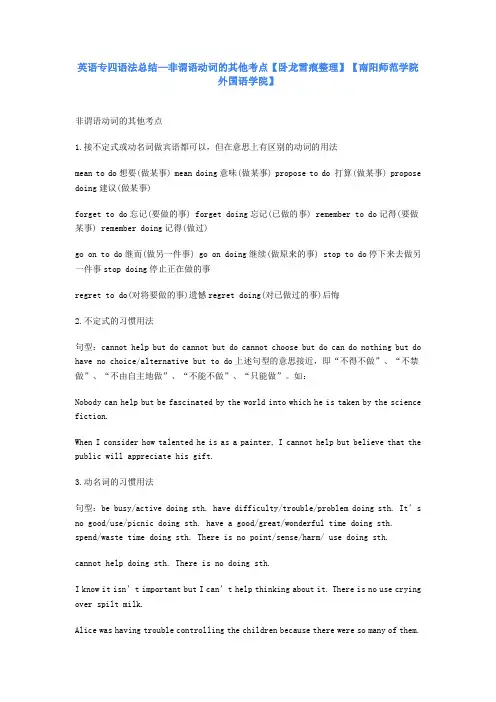
英语专四语法总结—非谓语动词的其他考点【卧龙雪痕整理】【南阳师范学院外国语学院】非谓语动词的其他考点1.接不定式或动名词做宾语都可以,但在意思上有区别的动词的用法mean to do想要(做某事) mean doing意味(做某事) propose to do 打算(做某事) propose doing建议(做某事)forget to do忘记(要做的事) forget doing忘记(已做的事) remember to do记得(要做某事) remember doing记得(做过)go on to do继而(做另一件事) go on doing继续(做原来的事) stop to do停下来去做另一件事stop doing停止正在做的事regret to do(对将要做的事)遗憾regret doing(对已做过的事)后悔2.不定式的习惯用法句型:cannot help but do cannot but do cannot choose but do can do nothing but do have no choice/alternative but to do上述句型的意思接近,即“不得不做”、“不禁做”、“不由自主地做”、“不能不做”、“只能做”。
如:Nobody can help but be fascinated by the world into which he is taken by the science fiction.When I consider how talented he is as a painter, I cannot help but believe that the public will appreciate his gift.3.动名词的习惯用法句型:be busy/active doing sth. have difficulty/trouble/problem doing sth. It’s no good/use/picnic doing sth. have a good/great/wonderful time doing sth. spend/waste time doing sth. There is no point/sense/harm/ use doing sth.cannot help doing sth. There is no doing sth.I know it isn’t important but I can’t help thinking about it. There is no use crying over spilt milk.Alice was having trouble controlling the children because there were so many of them.4.there be 非谓语动词的用法(1)做宾语时取决于谓语动词的持续要求。
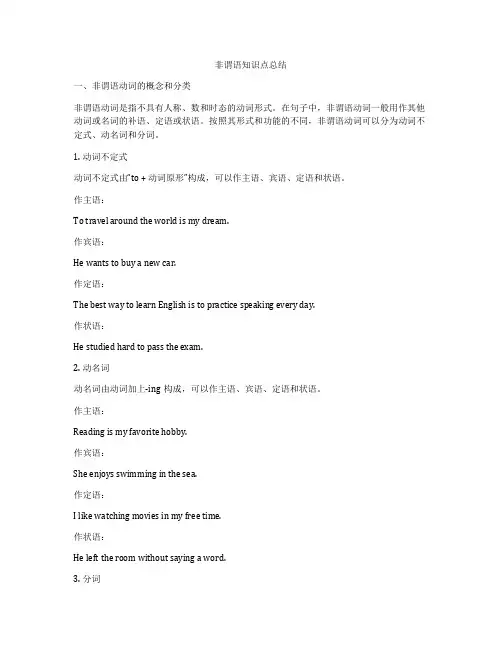
非谓语知识点总结一、非谓语动词的概念和分类非谓语动词是指不具有人称、数和时态的动词形式。
在句子中,非谓语动词一般用作其他动词或名词的补语、定语或状语。
按照其形式和功能的不同,非谓语动词可以分为动词不定式、动名词和分词。
1. 动词不定式动词不定式由“to + 动词原形”构成,可以作主语、宾语、定语和状语。
作主语:To travel around the world is my dream.作宾语:He wants to buy a new car.作定语:The best way to learn English is to practice speaking every day.作状语:He studied hard to pass the exam.2. 动名词动名词由动词加上-ing构成,可以作主语、宾语、定语和状语。
作主语:Reading is my favorite hobby.作宾语:She enjoys swimming in the sea.作定语:I like watching movies in my free time.作状语:He left the room without saying a word.3. 分词分词有现在分词和过去分词两种形式,现在分词一般以-ing结尾,过去分词一般以-ed、en、t结尾,可以作定语、状语和补语。
现在分词作定语:The girl standing by the door is my sister.现在分词作状语:She came home, feeling tired and hungry.过去分词作定语:The film directed by him won the best picture award.过去分词作补语:I was surprised to see the door closed.二、非谓语动词的用法1. 动词不定式(1)作主语To leave now is the best decision.(2)作宾语I want to learn English well.(3)作定语I have a book to read.(4)作状语He works hard to support his family.2. 动名词(1)作主语Swimming is good for health.(2)作宾语I enjoy reading books in my free time.(3)作定语The boy standing there is my brother.(4)作状语He goes to the gym every day, practicing yoga.3. 分词(1)现在分词作定语The girl sitting next to me is my best friend.(2)现在分词作状语Smiling happily, she accepted the gift.(3)过去分词作定语The meal cooked by my mother tastes delicious.(4)过去分词作补语I was excited to hear the news announced by the principal.三、非谓语动词形式的转换1. 从动词不定式到动名词动词不定式to do可以变为动名词doing,例如:I like to swim.(动词不定式)I like swimming.(动名词)2. 从动名词到动词不定式动名词doing可以变为动词不定式to do,例如:We enjoyed singing together.(动名词)We enjoyed to sing together.(动词不定式)3. 从动词不定式到分词动词不定式to do可以变为现在分词doing和过去分词done,例如:He is busy with his work.(动词不定式)He is busy doing his work.(现在分词)He is busy done his work.(过去分词)四、非谓语动词的特殊用法1. 不定式的被动语态动词不定式的被动语态结构为“to be + 过去分词”,例如:He is said to be a good student.2. 动名词的所有格形式动名词的所有格形式是在动名词后面直接加上“的”,例如:I remember his coming to see me.3. 分词作状语表示时间、原因、条件和方式现在分词和过去分词作状语表示时间、原因、条件和方式,例如:Being an experienced teacher, she knows how to deal with children. Having finished her homework, she went to bed.4. 动词不定式作目的状语动词不定式作目的状语表示目的或结果,通常放在句子后面,例如:He ran fast to catch the bus.五、非谓语动词的练习1. 单项选择题(1)We should encourage the students ____ more exercise every day.A. doB. to doC. doingD. are doing(2)I enjoy _____ in the garden in my free time.A. to workB. workingC. worksD. worked(3)The news _____ by the teacher surprised everyone.A. announceB. announcingC. announcedD. to announce2. 填空练习(1)_____ up early in the morning, she went for a run.(2)He wants _____ to the school team next year.(3)She likes _____ to music in her room.3. 句子翻译(1)他想去看电影。

英语专业四级语法重点汇总English英语专八专四学习复习资料英语专四语法重点汇总一、非谓语动词的主要考点1. 有些典型动词后面可以接上不定式或动名词来做宾语的,但是在意思上是有区别的,主要常考到的动词罗列如下:mean to do想要(做某事)VS mean doing意味(做某事)propose to do 打算(做某事)VS propose doing建议(做某事)forget to do忘记(要做的事)VS forget doing忘记(已做的事)remember to do记得(要做某事)VS remember doing记得(做过)go on to do继而(做另一件事)VS go on doing继续(做原来的事)stop to do停下来去做另一件事VS stop doing停止正在做的事regret to do(对将要做的事)遗憾VS regret doing(对已做过的事)后悔2. 不定式的习惯用法典型句型整理如下:如:“cannot help but do”——“不得不做某事”如:“cannot but do”——“不禁做某事”如:“cannot choose but do”——“不由自主地做某事”如:“can do nothing but do”——“不能不做某事”如:“have no choice but to do”——“只能做某事”如:“have no alternative but to do”——“只能做某事”例句:The boy cannot help but be greatly influenced by the useful instruction given by his family tutor.When I start my job career, I cannot choose but look back upon the beautiful days I spent on campus.3. 动名词的习惯用法典型动名词的习惯句型整理罗列如下:如:be busy/active doing sth.如:It’s no good/use doing sth.如:spend/waste time doing sth.如:have difficulty/trouble/problem doing sth.如:have a good/great/wonderful time doing sth.如:There is no point/sense/harm/ use doing sth.例句:There is no use crying over spilt milk.(典型例句)牛奶洒了,哭也没用;后悔是没有用的;覆水难受I really have problem solving these mathematic questions since I am not major in science after all.二、形容词与副词及其比较级1. 形容词的句法功能形容词通常在句子中用做定语、表语与主语的语法成分,通常考到的知识点总结如下:(1) 以“a”开头的形容词如“alone”、“alike”、“asleep”、“awake”等一般不能做前置定语,通常是做表语或后置定语的例句:Jerry didn’t pass the important final exam, please let him alone for the time being.Michael came back from job just now, and his eyes were shut and he seemed to have fallen asleep.(2) 某些以副词词缀“-ly”结尾的词其实是形容词,不能看错是副词,例如“friendly”、“leisurely”、“lovely”等(3) 下列动词既是实义动词又是系动词,注意用做系动词时,要求形容词做表语这些典型单词罗列如下:“remain”、“keep”、“become”、“get”、“grow”、“go”、“come”、“turn”、“stay”、“stand”、“run”、“prove”、“seem”、“appear”、“look”等例句:The situation remains tense between the two countries at this juncture. 在这个节骨眼上,两国形势仍然持续紧张。
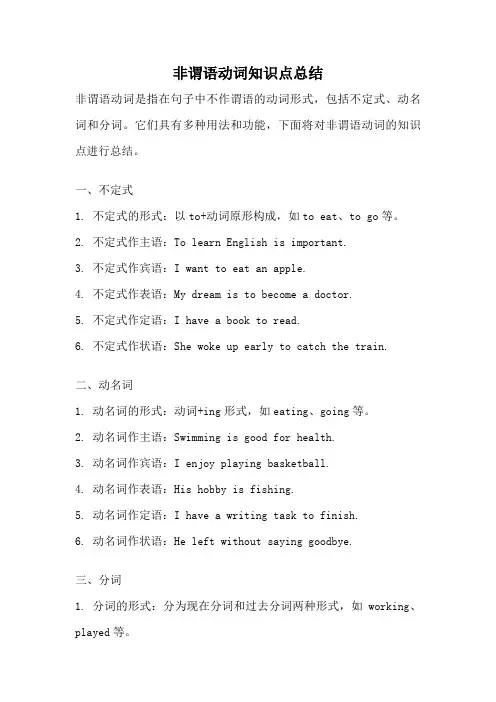
非谓语动词知识点总结非谓语动词是指在句子中不作谓语的动词形式,包括不定式、动名词和分词。
它们具有多种用法和功能,下面将对非谓语动词的知识点进行总结。
一、不定式1. 不定式的形式:以to+动词原形构成,如to eat、to go等。
2. 不定式作主语:To learn English is important.3. 不定式作宾语:I want to eat an apple.4. 不定式作表语:My dream is to become a doctor.5. 不定式作定语:I have a book to read.6. 不定式作状语:She woke up early to catch the train.二、动名词1. 动名词的形式:动词+ing形式,如eating、going等。
2. 动名词作主语:Swimming is good for health.3. 动名词作宾语:I enjoy playing basketball.4. 动名词作表语:His hobby is fishing.5. 动名词作定语:I have a writing task to finish.6. 动名词作状语:He left without saying goodbye.三、分词1. 分词的形式:分为现在分词和过去分词两种形式,如working、played等。
2. 现在分词作主语:Reading helps improve vocabulary.3. 现在分词作宾语:She heard someone calling her name.4. 现在分词作表语:He is a hardworking student.5. 现在分词作定语:I saw a running dog in the park.6. 现在分词作状语:He left the room, closing the door behind him.7. 过去分词作宾语补足语:I found the door closed.四、非谓语动词的逻辑主语1. 不定式的逻辑主语:It is important to learn English.2. 动名词的逻辑主语:Swimming helps improve health.3. 分词的逻辑主语:Reading books is beneficial for children.五、非谓语动词的否定形式1. 不定式的否定形式:not+不定式,如not to go、not to eat等。
非谓语动词知识点总结非谓语动词是指在句子中充当动词的形式,但不具备谓语的功能。
它可以作为动词、形容词或副词的补充,用来修饰主语或宾语。
非谓语动词包括动词不定式、动名词和分词。
在英语中,非谓语动词的使用非常灵活,可以丰富句子结构,增强表达的准确性和流畅度。
一、动词不定式动词不定式是非谓语动词的一种形式,由“to + 动词原形”构成。
动词不定式可以作为主语、宾语、表语、定语和状语等,具有多种用法。
1. 动词不定式作主语动词不定式作主语时,常常放在句首,后面跟动词原形。
例如:To travel around the world is my dream.旅行世界是我的梦想。
2. 动词不定式作宾语动词不定式作宾语时,常常放在动词后面。
例如:I want to learn how to play the guitar.我想学习弹吉他。
3. 动词不定式作表语动词不定式作表语时,常常放在系动词后面。
例如:Her dream is to become a doctor.她的梦想是成为一名医生。
4. 动词不定式作定语动词不定式作定语时,常常放在名词前面,修饰名词。
例如:The best way to learn English is to practice every day.学习英语的最好方法是每天练习。
5. 动词不定式作状语动词不定式作状语时,常常放在句子后面,修饰整个句子。
例如:He woke up early to catch the train.他早起赶火车。
二、动名词动名词是非谓语动词的一种形式,它是动词加上-ing构成的名词。
动名词可以作主语、宾语、表语、定语和状语等,具有多种用法。
1. 动名词作主语动名词作主语时,常常放在句首。
例如:Swimming is good for your health.游泳对健康有益。
2. 动名词作宾语动名词作宾语时,常常放在动词后面。
例如:I enjoy reading books in my free time.我喜欢在空闲时间读书。
(详细版)非谓语动词总结要点非谓语动词总结要点一、非谓语动词的基本概念非谓语动词是指在句子中充当动词的成分,但不具备时态和人称变化。
常见的非谓语动词包括动词不定式、动名词和分词。
二、动词不定式的特点和用法1. 动词不定式的特点:不定式一般由to + 动词原形构成。
2. 动词不定式的用法:- 作主语:To travel around the world is my dream.- 作宾语:She loves to sing and dance.- 作宾语补足语:They want me to join their team.- 作状语:I study hard to improve my English.- 与某些动词连用,如hope, expect, want, agree等:I hope to see you soon.三、动名词的特点和用法1. 动名词的特点:动名词一般由动词-ing形式构成。
2. 动名词的用法:- 作主语:Swimming is good for your health.- 作宾语:I enjoy reading books.- 作宾语补足语:She found pleasure in helping others.- 作定语:The running water sounds relaxing.四、分词的特点和用法1. 分词的特点:分词形式有现在分词(-ing形式)和过去分词(-ed或其他形式)。
2. 分词的用法:- 现在分词作状语:Seeing the accident, he hurried to call an ambulance.- 过去分词作定语:The broken window needs to be repaired.五、非谓语动词的时态和语态非谓语动词没有时态和人称变化,但可以与助动词连用,表示完成、进行、将来等不同的时态。
同时,非谓语动词也可以使用被动语态。
最全的非谓语动词知识点总结非谓语动词是指动词的非动词形式,分为动词不定式、动名词和现在分词、过去分词。
下面是非谓语动词的最全知识点总结:一、动词不定式(Infinitive)1.动词不定式的形式:- 常规形式:to+动词原形(to do)- 被动形式:to be done- 完成形式:to have done2.动词不定式的用法:- 作主语:To read books is my hobby.- 作宾语:I want to go home.- 作定语:Can you give me something to eat?- 作状语:I study hard to pass the exam.3.动词不定式与一些动词搭配:- 动词make, let, have, help后接动词原形作宾语:She made me clean the room.- 动词比如tell, ask, advise, want, expect后可接动词不定式作宾语补足语:She told me to go there.二、动名词(Gerund)1.动名词的形式:- 动词原形+ing(doing)2.动名词的用法:- 作主语:Swimming is good for health.- 作宾语:I enjoy reading books.- 作表语:His job is teaching English.- 作定语:The running water sounds relaxing.- 作状语:I walked home, singing songs.3.动名词与一些动词搭配:- 动词stop, finish, keep, mind后接动名词作宾语:He finished reading the book.- 动词enjoy, dislike, mind后接动名词作宾语:I enjoy swimming.三、现在分词(Present Participle)1.现在分词的形式:- 原形+ing(doing)2.现在分词的用法:- 作定语:The crying baby needs attention.- 作状语:He left the party, feeling disappointed.3.现在分词与一些动词搭配:- 动词keep, catch, find后接现在分词作宾补:I caught him stealing my money.- 动词see, hear, notice后接现在分词作宾补:I saw him walking in the park.四、过去分词(Past Participle)1.过去分词的形式:- 动词的过去分词形式(done)2.过去分词的用法:- 用于完成时态:I have finished my homework.- 用于被动语态:The book was written by him.3.过去分词与一些动词搭配:- 动词have, has, had, get, be等后接过去分词构成完成时态:He has eaten breakfast.- 动词make, let, have, get后接过去分词构成被动语态:She was made to clean the room.。
非谓语动词知识点总结非谓语动词是英语语法中重要的一部分,它包括不定式、动名词和分词。
掌握非谓语动词的用法和特点对于学习英语语法和提高语言表达能力非常重要。
本文将对非谓语动词的知识点进行总结和归纳。
一、不定式1. 不定式的基本形式:不定式是动词的一种形式,一般由“to + 动词原形”构成,例如:to go, to eat, to play等。
不定式可以作为动词、名词或形容词的宾语、表语、定语等。
2. 不定式的用法:a. 作为动词的宾语:He wants to go home. (他想回家。
)b. 作为名词的宾语:I like to swim. (我喜欢游泳。
)c. 作为形容词的宾语补足语:It is difficult to learn a new language. (学一门新语言很困难。
)3. 不定式的否定形式:不定式的否定形式通常是在“to”之前加上“not”,构成“not to + 动词原形”,例如:not to go, not to eat等。
4. 不定式的完成形式:不定式的完成形式由“to have + 动词过去分词”构成,例如:to have gone, to have eaten等。
5. 不定式的被动形式:不定式的被动形式由“to be + 动词过去分词”构成,例如:to be done, to be eaten等。
6. 不定式的完成被动形式:不定式的完成被动形式由“to have been + 动词过去分词”构成,例如:to have been done, to have been eaten等。
二、动名词1. 动名词的基本形式:动名词是动词的一种形式,一般以动词原形加上-ing构成,例如:going, eating, playing等。
动名词可以作为名词的主语、宾语、表语等。
2. 动名词的用法:a. 作为名词的主语:Swimming is good exercise. (游泳是一项好的锻炼。
非谓语知识点专题总结一、非谓语动词的定义非谓语动词是指不带有人称和数的动词形式,不具有谓语功能,在句子中作状语、宾语、主语、表语等。
通常包括不定式、动名词和动词的现在分词和过去分词。
二、不定式1.不定式的构成不定式的一般结构是 to + 动词原形,例如:to go,to play。
2.不定式的用法(1)作主语To learn English is important.学习英语很重要。
(2)作宾语I want to see you.我想见你。
(3)作宾补She made him promise to buy a new car.她让他答应买一辆新车。
(4)作状语He came to play with us.他来和我们一起玩。
(5)不定式做状语,可以表示目的、原因、结果和条件等。
例如:He got up early to catch the first bus.他早早起床是为了赶上第一班公共汽车。
三、动名词1.动名词的构成动名词的一般结构是动词原形 + -ing,例如:going,playing。
2.动名词的用法(1)作主语Playing basketball is my hobby.打篮球是我的爱好。
(2)作宾语I enjoy swimming in the sea.我喜欢在海里游泳。
(3)作宾补He kept me waiting for an hour.他让我等了一个小时。
(4)作定语She likes reading books.她喜欢读书。
(5)作状语I saw him running in the park.我看见他在公园里跑步。
四、动词的现在分词和过去分词1. 现在分词的构成现在分词的一般结构是动词原形 + -ing,例如:going,playing。
2. 过去分词的构成过去分词的构成形式有规律和不规律两种,例如:played, swum。
3.现在分词和过去分词的用法现在分词和过去分词通常作定语或表语,修饰名词或代词。
非谓语动词的其他考点
1.接不定式或动名词做宾语都可以,但在意思上有区别的动词的用法
mean to do想要(做某事) mean doing意味(做某事) propose to do 打算(做某事) propose doing建议(做某事)
forget to do忘记(要做的事) forget doing忘记(已做的事) remember to do记得(要做某事) remember doing记得(做过)
go on to do继而(做另一件事) go on doing继续(做原来的事) stop to do停下来去做另一件事stop doing停止正在做的事
regret to do(对将要做的事)遗憾regret doing(对已做过的事)后悔
2.不定式的习惯用法
句型:cannot help but do cannot but do cannot choose but do can do nothing but do have no choice/alternative but to do上述句型的意思接近,即“不得不做”、“不禁做”、“不由自主地做”、“不能不做”、“只能做”。
如:
Nobody can help but be fascinated by the world into which he is taken by the science fiction.
When I consider how talented he is as a painter, I cannot help but believe that the public will appreciate his gift.
3.动名词的习惯用法
句型:be busy/active doing sth. have diffi culty/trouble/problem doing sth. It’s no good/use/picnic doing sth. have a good/great/wonderful time doing sth. spend/waste time doing sth. There is no point/sense/harm/ use doing sth.
cannot help doing sth. There is no doing sth.
I know it isn’t important but I can’t help thinking about it. There is no use crying over spilt milk.
Alice was having trouble controlling the children because there were so many of them.
4.there be 非谓语动词的用法
(1)做宾语时取决于谓语动词的持续要求。
如:
The students expected there to be more reviewing classes before the final exams.(expect要求接不定式做宾语)
(2)做目的状语或程度状语时用for there to be,做其他状语用there being。
如:
For there to be successful communication, there must be attentiveness and involvement in the discussion itself by all present.
(for there to be…在句中做目的状语)
It isn’t cold enough for there to be a frost tonight, so I can leave Jim’s car out quite safely. (for there to be…在句中做程度状语)
There being no further questions, we’ll stop here today. (there being…做原因状语)
(3)引导主语用for there to be。
如:It is unusual for there to be no late comers today.
(4)做除for外的介词宾语,用there being。
如:
He would always ignore the fact of there being such a contradiction in his inner thought.。